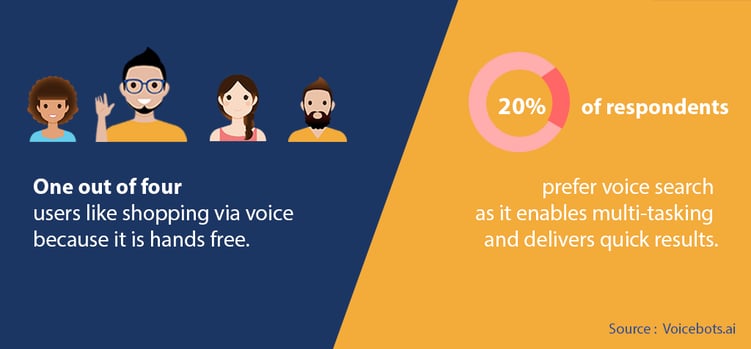Search is changing, and so is the way consumers choose to engage with businesses local or global. There is a distinct move away from screens and keyboards, and into voice-based interactions. Voice-search is becoming a fast growing habit across consumer segments, and fundamentally transforming how people and businesses transact on the internet.
Voice Search is Picking Pace
Consider this:
- A report suggests that speech and voice recognition market will be worth $26.8 billion by 2025, growing at a CAGR of 17.2% from 2019
- 65% of consumers ages 25-49 years old talk to their voice-enabled devices daily, according to PwC.
All this point to the fact that the future of search is voice-first. This is primarily owing to the fact that voice search is user-friendly.
What’s the easier out of these two options?
- Unlocking your phone, opening a browser, typing a search query, scrolling through the options, and selecting the best one, OR
- Just saying “OK Google” or “Alexa, followed by a query, and getting your answer
In an era of short attention spans and multi-tasking lifestyles, the easier and faster option is always the better option, whether it’s pizza or search results.
Voice assistants fetch you one answer, the best answer, to your query. And you can get your answers without distracting yourself from anything else that you are doing simultaneously.
Basically, voice search brings in a degree of convenience that customers are rapidly growing accustomed to.
What Does That Mean for Businesses?
Given the increasing popularity of voice-search, it is fast becoming an important channel for prospective customers to find and interact with your brand. In the absence of a visual interface, or a list of options, customers increasingly rely on the voice assistants’ first answer.
This interaction design severely limits your chances of getting in front of your customers. Businesses should expect steep fall in site traffic, brand awareness and engagement metrics if they are not prepared to serve voice-based search queries.
So, how do you serve voice search?
The answer is to get your enterprise content ready to respond to voice-based queries. While that might seem like an obvious next step, it does require significant planning and forward thinking. Also, it’s not as simple as feeding your existing content on web pages and blogs and ebooks into a voicebot database.
Let’s take a look at the key considerations to get your content ready for a voice-first world:
Voice-based content needs to be created differently
The way we speak and understand verbal communication is markedly different from the way we understand written information. So the content you create to serve voice search has to conform to certain standards:
Concise: People have lower attention span for verbal information, especially in the absence of a face to anchor the conversation. While responding to voice-based queries, your content/ information snippet has to be one short answer, to ensure attention and retention.
Clarity: While voice-based answers have to be short, they also have to give enough information to make the answer clear and understandable.
Provide Context: Since voice-based content is only heard and not seen, all contextual interaction clues are missing. The context has to be communicated verbally, for the user to know the next steps, or what to expect.
For example: On a webpage for industrial cleaning machinery, you can have a hyperlink that says “find more information here”. The customer can see it and knows what to expect when she clicks the link. She has visual context.
However, when the information is voice-based, simply translating the hyperlink text to voice will not suffice. Your content will have to be modified into a question that says, “Would you like more information on industrial cleaning machinery?”, to which the customer can respond by clicking or typing yes or no.
Voice-based content has to be optimized differently
Voice-search optimization is heavily focused on usability and creating an intuitive search experience. Some of the key tenets for voice optimization would be:
Leveraging long-tail keywords: Because voice-search is easier, the search queries are more conversational and longer than typed queries.
For instance, a user might type “Buy Ferrero Rochers” on Google, but if he’s searching through a voicebot, it’s more likely that he’ll say “Hey Google, I’d like to buy some Ferrero Rochers”.
Thus, long tail keywords, that perfectly align with user intent, should be targeted while preparing voice-based content.
Featured snippets: Coming at the top of the search pages, even before rank one results, these snippets are very often used as the answer for voice searches. With only a few tweaks, it is possible to create segments in your content that be picked by Google as the featured snippet, thus increasing your chances of being the answer to a voice-based query.
Answer questions: Voice-searches are often articulated as specific questions. So creating short content pieces that answer expected consumer questions is the best way to leverage voice-search. Even after offering an answer, voice assistants should prompt relevant expected questions, to lead users to other results.
Use microdata markup: Markups like schema.org and Dublin Core can be used to mark-up your HTML code, to structure your metadata. Just like it works for text-based search, this markup can also optimize portions of your content to be picked to serve voice-based queries.
Voice-search is easy, convenient, and reliable - everything that customers want when they are searching for something. They are fast moving to this mode of interaction and businesses have to keep up, if they wish stay relevant. So whether it’s optimizing your content to serve voice-search, or creating voicebots to make your content more accessible, you need a voice strategy in place.
You could also check out:
Webinar: Voice-First World - Are You Ready For the Bots?
Blog: The Alexa Skills Race: Is Your Enterprise Keeping Up?
Blog: Why Voice Technology is the Next Big Investment for Media Enterprises
Srijan is helping enterprises explore the new opportunities in a voice-first world, and capitalize on them with the right technology solutions. Book a call with our expert team, and let’s see how your enterprise can be prepared to leverage voice-search.
Our Services
Customer Experience Management
- Content Management
- Marketing Automation
- Mobile Application Development
- Drupal Support and Maintanence
Enterprise Modernization, Platforms & Cloud
- Modernization Strategy
- API Management & Developer Portals
- Hybrid Cloud & Cloud Native Platforms
- Site Reliability Engineering





